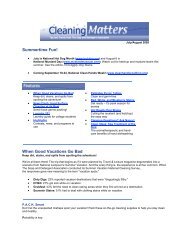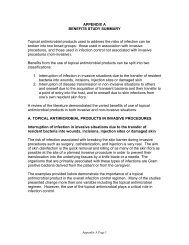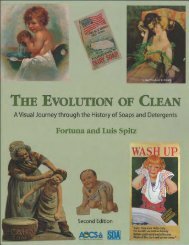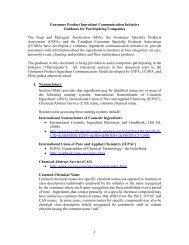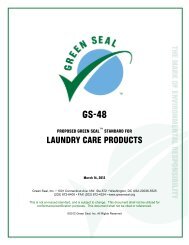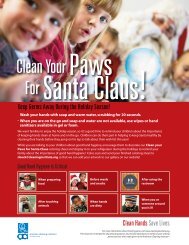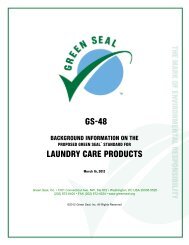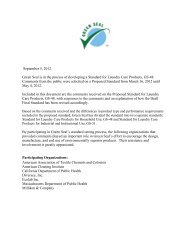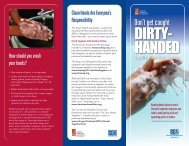subchapter c -- federal hazardous substances act regulations
subchapter c -- federal hazardous substances act regulations
subchapter c -- federal hazardous substances act regulations
You also want an ePaper? Increase the reach of your titles
YUMPU automatically turns print PDFs into web optimized ePapers that Google loves.
16 CFR Ch. II (1–1–05 Edition) – proposed modification – 6/25/06<br />
(2) Common matches, including book<br />
matches, wooden matches, and socalled<br />
“safety” matches are exempt from the labeling<br />
requirements of section 2(p)(1) of the <strong>act</strong><br />
(repeated in § 1500.3(b)(14)(i)) insofar as they<br />
apply to the product being considered<br />
<strong>hazardous</strong> because of being “flammable” or<br />
“extremely flammable” as defined in §<br />
1500.3(c)(6)(iii) and (iv).<br />
(3) Paper items such as newspapers,<br />
wrapping papers, toilet and cleansing tissues,<br />
and paper writing supplies are exempt from<br />
the labeling requirements of section 2(p)(1) of<br />
the <strong>act</strong> (repeated in § 1500.3(b)(14)(i)) insofar<br />
as they apply to the products being considered<br />
<strong>hazardous</strong> because of being “flammable” or<br />
“extremely flammable” as defined in §<br />
1500.3(c)(6)(iii) and (iv).<br />
(4) Thread, string, twine, rope, cord, and<br />
similar materials are exempt from the labeling<br />
requirements of section 2(p)(1) of the <strong>act</strong><br />
(repeated in § 1500.3(b)(14)(i)) insofar as they<br />
apply to the products being considered<br />
<strong>hazardous</strong> because of being “flammable” or<br />
“extremely flammable” as defined in §<br />
1500.3(c)(6) (iii) and (iv).<br />
(5) Laboratory chemicals intended only for<br />
research or investigational and other<br />
laboratory uses (except those in home<br />
chemistry sets) are exempt from the<br />
requirements of placement provided in §<br />
1500.121 if all information required by that<br />
section and the <strong>act</strong> appears with the required<br />
prominence on the label panel adjacent to the<br />
main panel.<br />
(6) [Reserved]<br />
(7) Rigid or semirigid ballpoint ink<br />
cartridges are exempt from the labeling<br />
requirements of section 2(p)(1) of the <strong>act</strong><br />
(repeated in § 1500.3(b)(14)(i)), insofar as<br />
such requirements would be necessary because<br />
the ink contained therein is a “toxic” substance<br />
as defined in § 1500.3(c)(2)(i), if:<br />
(i) The ballpoint ink cartridge is of such<br />
construction that the ink will, under any<br />
reasonably foreseeable conditions of<br />
manipulation or use, emerge only from the<br />
ballpoint end;<br />
(ii) When tested by the method described<br />
in § 1500.3(c)(2)(i), the ink does not have an<br />
LD-50 single oral dose of less than 500<br />
milligrams per kilogram of body weight of the<br />
test animal; and<br />
-- 66 --<br />
(iii) The cartridge does not have a capacity<br />
of more than 2 grams of ink.<br />
(8) Containers of paste shoe waxes, paste<br />
auto waxes, and paste furniture and floor<br />
waxes containing toluene (also known as<br />
toluol), xylene (also known as xylol),<br />
petroleum distillates, and/or turpentine in the<br />
concentrations described in § 1500.14(a)(3)<br />
and (5) are exempt from the labeling<br />
requirements of §1500.14(b)(3)(ii) and (5) if<br />
the visicosity of such products is sufficiently<br />
high so that they will not flow from their<br />
opened containers when inverted for 5 minutes<br />
at a temperature of 80 °F., and are exempt<br />
from bearing a flammability warning statement<br />
if the flammability of such waxes is due solely<br />
to the presence of solvents that have<br />
flashpoints above 80 °F. when tested by the<br />
method described in § 1500.43.<br />
(9) Porous-tip ink-marking devices are<br />
exempt from the labeling requirements of<br />
section 2(p)(1) of the <strong>act</strong> (repeated in §<br />
1500.3(b)(14)(i)) and from the labeling<br />
requirements of § 1500.14(b)(1), (2), and<br />
(3)(ii) and (iii) insofar as such requirements<br />
would be necessary because the ink contained<br />
therein is a toxic substance as defined in §<br />
1500.3(c)(2)(i), and/or because the ink<br />
contains 10 percent or more by weight of<br />
toluene (also known as toluol), xylene (also<br />
known as xylol), or petroleum distillates as<br />
defined in § 1500.14(a)(3), and/or because the<br />
ink contains 10 percent or more by weight of<br />
ethylene glycol; provided that:<br />
(i) The porous-tip ink-marking devices are<br />
of such construction that:<br />
(A) The ink is held within the device by an<br />
absorbent material so that no free liquid is<br />
within the device; and<br />
(B) Under any reasonably foreseeable<br />
conditions of manipulation and use, including<br />
reasonably foreseeable abuse by children, the<br />
ink will emerge only through the porous<br />
writing nib of the device; and<br />
(ii)(A) The device has a capacity of not<br />
more than 10 grams of ink and the ink, when<br />
tested by methods described in §<br />
1500.3(c)(2)(i), has an LD-50 single oral dose<br />
of not less than 2.5 grams per kilogram of<br />
body weight of the test animal; or<br />
(B) The device has a capacity of not more<br />
than 12 grams of ink and the ink, when tested<br />
by methods described in § 1500.3(c)(2)(i), has<br />
an LD-50 single oral dose of not less than 3.0



